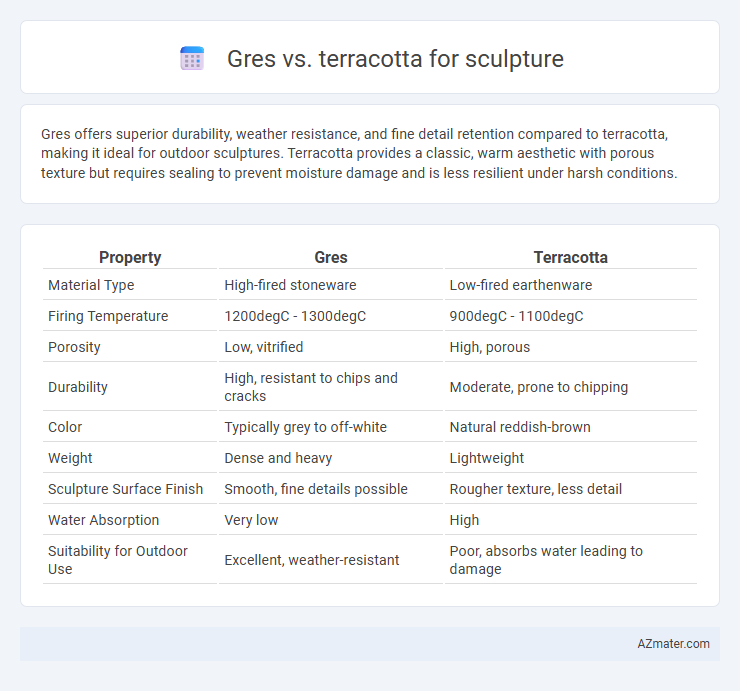Gres offers superior durability, weather resistance, and fine detail retention compared to terracotta, making it ideal for outdoor sculptures. Terracotta provides a classic, warm aesthetic with porous texture but requires sealing to prevent moisture damage and is less resilient under harsh conditions.
Table of Comparison
| Property | Gres | Terracotta |
|---|---|---|
| Material Type | High-fired stoneware | Low-fired earthenware |
| Firing Temperature | 1200degC - 1300degC | 900degC - 1100degC |
| Porosity | Low, vitrified | High, porous |
| Durability | High, resistant to chips and cracks | Moderate, prone to chipping |
| Color | Typically grey to off-white | Natural reddish-brown |
| Weight | Dense and heavy | Lightweight |
| Sculpture Surface Finish | Smooth, fine details possible | Rougher texture, less detail |
| Water Absorption | Very low | High |
| Suitability for Outdoor Use | Excellent, weather-resistant | Poor, absorbs water leading to damage |
Introduction to Gres and Terracotta
Gres and terracotta are popular ceramic materials widely used in sculpture, each offering distinct properties and aesthetic qualities. Gres, often referred to as stoneware, is a dense, non-porous clay fired at high temperatures, resulting in a durable and water-resistant surface ideal for outdoor and functional art pieces. Terracotta, derived from porous red clay and fired at lower temperatures, provides a warm, earthy texture that enhances the organic feel and traditional appeal of sculptural works.
Historical Significance in Sculpture
Gres and terracotta have both played vital roles in the history of sculpture, with terracotta dating back to ancient civilizations like Mesopotamia and the Indus Valley, prized for its organic warmth and ease of molding. Gres, a refined stoneware clay, gained prominence in European sculptural traditions during the 19th and 20th centuries for its durability and ability to withstand outdoor conditions. These materials reflect evolving artistic techniques and cultural values, symbolizing a bridge between fragile antiquity and enduring modernity in sculptural art.
Material Composition and Properties
Gres sculptures are crafted from high-fired stoneware clay, resulting in a dense, durable material with low porosity and high resistance to frost and wear, ideal for outdoor installations. Terracotta uses a lower-fired earthenware clay, which is more porous and less strong, offering a warm, reddish-brown hue favored for indoor decorative pieces. The choice between gres and terracotta impacts longevity, finish, and suitability based on environmental exposure and desired aesthetic qualities.
Visual and Textural Differences
Gres offers a smooth, dense surface with a subtle matte finish, emphasizing fine details and precise lines in sculptures. Terracotta provides a warmer, earthy tone with a porous, rougher texture that brings organic, rustic character to the artwork. The visual contrast lies in gres's sleek uniformity versus terracotta's natural imperfections and tactile depth.
Techniques for Sculpting with Gres
Gres, or stoneware clay, offers superior durability and fine grain, making it ideal for detailed sculpting techniques such as carving, modeling, and incising. Its high firing temperature (around 1200-1300degC) ensures a vitrified, non-porous surface that enhances the longevity and strength of sculptures compared to terracotta, which fires at lower temperatures and remains porous. Sculptors favor gres for intricate textures and precise finishing, as it maintains structural integrity during multiple firings and complex glazing processes.
Techniques for Sculpting with Terracotta
Terracotta sculpting involves hand-building techniques such as pinching, coiling, and slab construction, allowing intricate detail and organic forms. This clay type requires careful attention to drying and firing processes to prevent cracking, often utilizing low to mid-range kiln temperatures around 1000-1150degC. Skilled artists exploit terracotta's porous texture for expressive surface finishes and patinas, creating warm, earthy tones distinct from denser Gres stoneware sculptures.
Durability and Longevity Comparison
Gres, a dense stoneware clay fired at high temperatures, offers superior durability and resistance to weathering, making it ideal for outdoor sculptures exposed to harsh conditions. Terracotta, made from low-fire clay, is more porous and susceptible to chipping, cracking, and erosion over time, especially when unglazed or used outdoors. For longevity in sculpture, gres ensures greater structural integrity and color retention, while terracotta requires careful sealing and maintenance to prevent deterioration.
Suitability for Indoor and Outdoor Sculpture
Gres, a dense and durable stoneware clay, offers exceptional resistance to weathering and moisture, making it highly suitable for outdoor sculptures exposed to varying climatic conditions. Terracotta, composed of porous earthenware clay, is ideal for indoor sculptures due to its vulnerability to frost and prolonged moisture, which can cause cracking or deterioration. Both materials provide distinct textural and aesthetic qualities, but gres's superior strength ensures longevity in exterior environments, whereas terracotta excels in controlled indoor settings.
Cost and Accessibility Factors
Gres, a dense stoneware clay, generally offers greater affordability and widespread availability compared to terracotta, making it a preferred choice for large-scale or commercial sculptures. Terracotta, known for its porous and reddish composition, can be more expensive due to specialized firing requirements and less consistent supply depending on regional clay sources. Sculptors often consider gres for budget-conscious projects seeking durability, while terracotta remains favored for traditional aesthetics despite potentially higher costs and limited local access.
Choosing the Right Material for Your Sculpture
Choosing the right material for your sculpture hinges on durability and aesthetic preference, with gres and terracotta offering distinct advantages. Gres, a dense stoneware fired at high temperatures, provides superior strength and water resistance, making it ideal for outdoor or large-scale sculptures. Terracotta, a porous earthenware fired at lower temperatures, offers a warm, natural finish suited for detailed work and indoor display, but requires sealing to prevent moisture damage.

Infographic: Gres vs Terracotta for Sculpture
 azmater.com
azmater.com